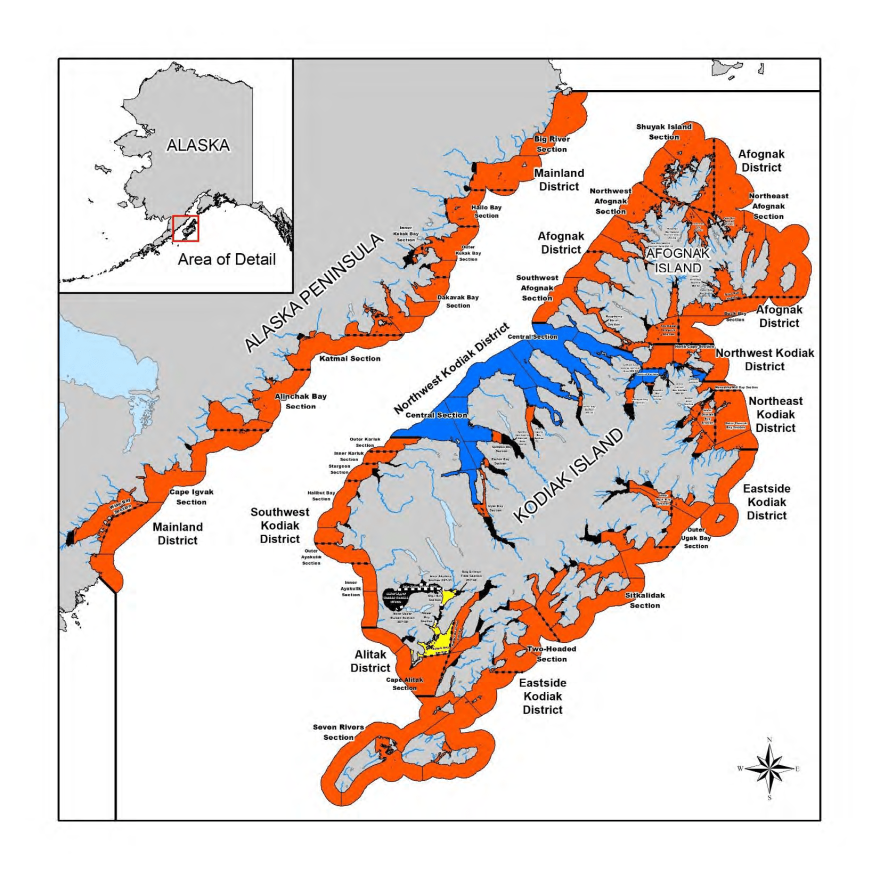Alaska’s Board of Fisheries approved small changes for the local salmon set net and purse seine fleets at its meeting in Kodiak last week, January 9th – 12th, while opting to keep the status quo overall for the westside of the island’s management strategy. But as KMXT’s Davis Hovey reports, the growing divide between the two gear groups was on full display.
Of the 91 people who signed up to give public comments, roughly a third of them discussed seining or set nets (gillnets) and the proposals dealing with their respective fishing gear. Out of the 31 total proposals before the Board of Fisheries, about ten considered management changes between the gear groups. BOF oversees fisheries management within state waters.
One proposal, for instance, number 64, doubled the allowable maximum hook size of a set gillnet from 25 fathoms to 50 fathoms in length and extended the total net length that can be used from 150 fathoms to 175 fathoms. The change is only applicable for the Central section of the Northwest Kodiak District which is the sole area open to both set gillnets and seine fishing, on the island. Proposal 64 in its original form was suggested by the Northwest Setnetters Association.
“We’re trying to work alongside a highly effective mobile gear group [seines],” Mark Beardsley, the President of the Northwest Setnetters Association, said. “It used to work in past decades but things have changed. It doesn’t seem to be working anymore for us,” he stated.
According to the group, there has been a significant drop in the harvest percentage of salmon by set netters since 2012, and proposal 64 would allow for a more equitable harvest. Beardsley advocated for multiple proposals, some of which would have created a separate time for gillnetters to fish without seiners being able to fish and establish an allocation just for gillnets. Proposals 62, 69 & 70 were all voted down unanimously by the Board of Fisheries.
Ultimately, the Board unanimously passed this proposal, with some amendments submitted by the Kodiak Seiners Association. The Association said this is, “an attempt to provide some relief to the Northwest Set net fleet during periods of open fishing. We recognize that any harvest increase due to this change would affect available fish that could be caught by seiners.”
This regulation change does not require set gillnetters to use a longer hook, but gives them the option to if they choose. Board of Fisheries member Mike Wood said this gear change will guarantee gillnetters catch more fish.
But, the Department of Fish & Game’s Area Management Biologist, James Jackson, said it is hard to quantify how this gear change will affect salmon harvest in areas outside of the Central section.
“This would definitely make the gear more efficient because it is going to be larger or you could potentially use a larger hook and so the potential for more harvest in the gillnet fleet could possibly harvest fish bound to Alitak [District],” Jackson explained. “But the seine fishery has larger nets than they [gillnets] do and they would still be fishing around the same time.”
As a sort of trade-off proposal for the seine fleet, the Board also decided to increase purse seine length by 25% from 200 fathoms to 250 fathoms and allow the seine mesh size to be up to seven inches. One lead no more than 100 fathoms in length may be used with each purse seine or hand purse seine. The aggregate length of seine and lead may not exceed 250 fathoms.
That separate proposal 66 had at least 30 people submit comments in opposition, the vast majority of whom also submitted support for proposal 64. While deliberating on these proposals Board of Fisheries Chair John Wood said he witnessed something he’s never seen before.
“An AC [Advisory Committee] came forward and then a large group of the members withdrew their support here at the Board. It’s clear to me that there is a division developing in this community that can be healed by at least reaching some accommodation on this [proposal 66] as well as what we’ve already done with the hook, etc [proposal 64],” Wood stated.
Initially the Kodiak Advisory Committee (AC) had voted in support of proposals 62, 64 & 66, but during the Board of Fisheries meeting, in an unprecedented move, several members rescinded their support of proposal 62, which was amended by the Northwest Setnetters Association and eventually voted down.
Board members opted not to approve some of the bigger requests before them, however, including changing fishing times to allow setnetters exclusive opportunities in the water.
The number of purse seiner permits peaked in the late 1990s at over 300 according to data shared by the Alaska Department of Fish & Game. But over the last five years, the average number of permits has been roughly half that at 168, while seiners have maintained or increased efficiency in harvesting fish. Meanwhile, the set net (gillnetters) have been harvesting less and less over the last decade.
Although the number of set gillnet permits has not dropped as significantly as seiners did since the 1990s, the last five-year average has been lower than their historical average of 144.
The division within Kodiak Island fishing groups has been exacerbated by a changing run of Karluk sockeye salmon in September. A shift in late-run timing has allowed seiners to increase their harvest since 2012, while set netters say they have been suffering during that same timeframe.
Board Chair Wood says he hopes the fishing community in Kodiak can close the gap between the two gear groups going forward.




